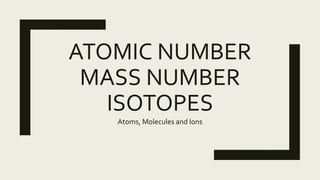
Lesson 2
- 1. ATOMIC NUMBER MASS NUMBER ISOTOPES Atoms, Molecules and Ions
- 2. ■ The atomic number of an atom is the number of protons in the nucleus of an atom.The atomic number determines the chemical properties of an element and its place in the periodic table. ■ Mass number is the sum of the protons and neutrons in a nucleus. ■ Atomic mass is the mass of an atom of a chemical element expressed in atomic mass units. It is approximately equivalent to the number of protons and neutron in the atom. It can be also computed by getting the average number allowing for the relative abundances of different isotopes. ■ Isotopes are atoms that have the same number of protons but different number of neutrons. – For example – protium, deuterium and tritium. All three of them are hydrogen. It means that they have an atomic number of 1 and has 1 proton each. However, protium has no neutrons, deuterium has 1 neutron and tritium has 2 neutrons.
- 3. ■ Isotopes are identified by their mass number. – Let us have an example. Oxygen – 15 is an isotope of oxygen.This isotope of oxygen has a mass number of 15. Carbon – 14 is an isotope of carbon.This isotope of carbon has a mass number of 14. ■ Isotopes are written in this format: – Where: ■ X – chemical symbol of the element ■ A – mass number ■ Z – atomic number
- 4. ■ For example, let us take tritium, one of the isotopes of hydrogen.Tritium has an isotopic symbol of: ■ Following the format this isotope has a mass number of 3 and an atomic number of 1. ■ Therefore, this isotope has a 1 proton and 2 neutrons
- 5. MOLECULAR FORMULA, EMPIRICAL FORMULA AND STRUCTURAL FORMULA Atoms, Molecules and Ions
- 6. ■ Molecular formula, empirical formula and structural formula are all examples of chemical formulas. All of them tell you the number of atoms of each element found in the compound. ■ Molecular formulas are chemical formulas that tell us the actual number of the different elements in a compound ■ Empirical formula is defined as the simplest ratio of whole numbers of elements that make up a compound.This type of formula is derived from experimental data.
- 7. ■ Molecular formula, empirical formula and structural formula are all examples of chemical formulas. All of them tell you the number of atoms of each element found in the compound. ■ Molecular formulas are chemical formulas that tell us the actual number of the different elements in a compound ■ Empirical formula is defined as the simplest ratio of whole numbers of elements that make up a compound.This type of formula is derived from experimental data.
- 8. ■ Structural formulas show both the actual number of atoms of the elements in a compound, how the atoms are arranged and which atoms are bonded to one another. – This is an example of a structural formula. From here, not only we can see that it has one carbon atom and 4 hydrogen atoms, we can also see how the carbon and hydrogen atoms are connected to each other.
- 9. ■ Molecular Models are physical models that represent molecules. They are used to visualize molecules. ■ There are two types of molecular models – the ball-and-stick model and space-filling models. – Ball-and-stick model makes use of wooden balls or plastics to represent the atoms. Sticks or springs are used to represent chemical bonds
- 10. – Space filling models are models wherein atoms are represented by truncated balls held together by snap fasteners. *The balls used in the ball-and-stick model are of the same size while the balls in space-filling models are proportional to the size of the atoms.